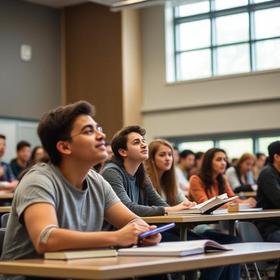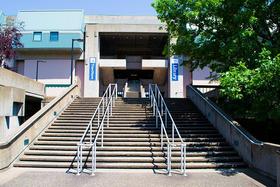- SFCC is an accessible, learning-centered institution, enriching its students and community by providing skills, knowledge and perspectives essential for a changing world.
School Highlights
State Fair Community College serves 4,666 students (46% of students are full-time).
The college's student-teacher ratio of 15:1 is lower than the state community college average of 16:1.
Minority enrollment is 19% of the student body (majority Hispanic), which is less than the state average of 41%.
Quick Facts (2025-26)
- Enrollment: 4,666 students
- In-state tuition: $3,288
- Out-state tuition: $4,752
- Student-teacher ratio: 15:1
- Minority enrollment: 19%
- Source: Integrated Postsecondary Education Data System (IPEDS)
Top Rankings
State Fair Community College ranks among the top 20% of public schools in Missouri for:
Category
Attribute
Affordability
School Overview
The teacher population of 316 teachers has stayed relatively flat over five years.
State Fair Community College
(MO) Community College Avg.
Carnegie Classification
Associate's Colleges: Mixed Transfer/Career & Technical-High Traditional
Baccalaureate Colleges: Diverse Fields
Institution Level
At least 2 but less than 4 years
At least 2 but less than 4 years
Institution Control
Public
Public
Total Faculty
316 staff
139 staff
School Calendar
Student Body
The student population of State Fair Community College has grown by 8% over five years.
The student-teacher ratio of 15:1 has increased from 12:1 over five years.
The State Fair Community College diversity score of 0.33 is less than the state average of 0.61. The school's diversity has stayed relatively flat over five years.
Total Enrollment
4,666 students
2,125 students
Student-Teacher Ratio
15:1
16:1
# Full-Time Students
2,142 students
718 students
# Part-Time Students
2,524 students
1,407 students
# Enrollment Undergraduate
466 students
246 students
# Full-Time Undergraduate Students
2,142 students
834 students
# Full-Time Graduate Students
n/a
11 students
# Part-Time Undergraduate Students
2,524 students
684 students
# Part-Time Graduate Students
n/a
9 students
Total Dormitory Capacity
204 students
200 students
% American Indian/Alaskan
n/a
n/a
% Asian
1%
2%
% Hispanic
9%
6%
% Black
3%
10%
% White
81%
59%
% Hawaiian
n/a
1%
% Two or more races
5%
4%
% Non Resident races
1%
1%
% Unknown races
n/a
17%
Diversity Score
0.33
0.61
College Completion Rate (Students who graduate in less than 4 years)
35%
43%
College Completion Rate (Students who graduate in 4 years or more than 4 years)
n/a
62%
Average Graduate Earnings (10 Years)
$32,100
$30,900
Tuition and Acceptance Rate
The public in-state tuition of $3,288 is less than the state average of $4,393. The in-state tuition has declined by 29% over four years.
The public out-state tuition of $4,752 is less than the state average of $6,050. The out-state tuition has declined by 22% over four years.
In-State Tuition Fees
$3,288
$4,393
Out-State Tuition Fees
$4,752
$6,050
% Students Receiving Some Financial Aid
92%
91%
Median Debt for Graduates
$10,500
$10,500
Median Debt for Dropouts
$5,500
$5,500
Acceptance Rate
n/a
94%
Source: 2024 (or latest year available) Integrated Postsecondary Education Data System (IPEDS) , School Administrators
School Notes
- From its humble beginnings when a single building served the first 436 students and 18 faculty members, SFCC has grown to encompass 11 buildings, including a student residence hall, all situated on 130 acres. Classes or dual credit courses are offered at the Sedalia campus, eight extended campus sites, and more than 20 other locations to more than 3,000 students. SFCC delivers classes or dual credit courses to 28 locations in 14 counties. Other locations served include Blair Oaks High School, Jefferson City; Boonville Correctional Center; California High School; Camdenton High School; Clinton High School; Cole Camp High School; Cole County R-V, Eugene; Concordia High School; Eldon High School; La Monte High School; Lincoln High School; Morgan County R-I, Stover; New Bloomfield High School; Nichols Career Center, Jefferson City; Northwest High School, Hughesville; Russellville High School; Sacred Heart High School, Sedalia; School of the Osage, Kaiser; Smith-Cotton High School, Sedalia; and Smithton High School. State Fair Community College offers associate of applied science degrees and professional certificates in nearly 30 programs, including the two newest offerings, dental hygiene and radiologic technology. In addition to vocational-technical degrees, SFCC offers an associate of arts degree, allowing for transfer to a baccalaureate program. The college is also the career and technical center for high schools within the district. Lifelong learning programs include adult basic education, literacy classes, customized training for industry, and a growing community education outreach program. SFCC has long held a place in the community as a source for arts entertainment with flourishing art, music and drama departments. SFCC is accredited by the North Central Association of Colleges and Schools.
Frequently Asked Questions
How much does State Fair Community College cost?
State Fair Community College's tuition is approximately $3,288 for In-State students and $4,752 for Out-State students.
What is State Fair Community College's ranking?
State Fair Community College ranks among the top 20% of community college in Missouri for: Least expensive tuition.
Recent Articles

The Rise of Technical and Vocational Training in 2025
Explore the 2025 surge in technical and vocational training—enrollment, policy, costs, and why this path is gaining ground for students and parents.

Stackable Credentials: How Community Colleges Advance Careers
Discover how community colleges use stackable credentials to build career pathways, boost earnings, and enable lifelong learning in 2025.

High-Paying Jobs You Can Get with a Community College Degree
Discover top high-paying careers you can launch in 2025 with a community college (associate) degree and high-growth credentials in tech, healthcare and trades.









